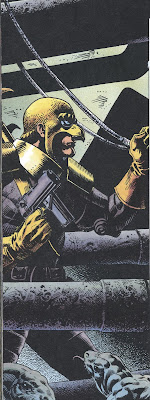Book Review: 'Nova 2' edited by Harry Harrison
3 / 5 Stars
‘Nova 2’ first was published in hardback in 1972; this Dell Books paperback (235 pp) was issued in April, 1974. The cover artist is uncredited.
All of the stories in ‘Nova 2’ were written specifically for the anthology.
The New Wave movement was firmly entrenched in 1972, although Harry Harrison was somewhat less enamored of ‘speculative fiction’ as compared to, say, Damon Knight. Thus, I was hoping that the entries in ‘Nova 2’ would avoid the worst excesses of the Movement.
In his Introduction Harrison focuses primarily on the growth of the genre in non-Anglophone countries, growth which, according to Harrison, justifies the inclusion of a novelette by the Brazilian author Andre Carneiro in ‘Nova 2’.
Harrison also reveals that satirical treatments of classic sf tropes and themes have become very much in style, hence his decision to include seven stories ‘....sparked with wit’.
My capsule summaries of the contents of ‘Nova 2’:
Zirn Left Unguarded, the Jenghik Palace in Flames, Jon Westerly Dead, by Robert Sheckley: by 1972 the repackaging of Edgar Rice Burroughs ‘Mars’ and ‘Venus’ novels into paperbacks had become big business; accordingly, Sheckley seeks to satirize this genre. Why Harrison saw a story this lame as deserving of being included in ‘Nova 2’ is mystifying.
East Wind, West Wind, by Frank M. Robinson: a detective story set amidst a near-future Los Angeles in the grip of devastating air pollution. One of the more effective stories in the anthology, and a classic of the early seventies Eco-Disaster genre.
The Sumerian Oath, by Philip Jose Farmer: humorous tale of an oath all physicians take – in secret, of course.
Now + n Now – n, by Robert Silverberg: nothing screams ‘New Wave’ like this title. It’s actually the rather pedestrian tale of Aram Kevorkian, who is in regular, telepathic contact with his selves both 48 hours into the future, and 48 hours into the past (48 hours being the ‘n’ of the title). Kevorkian earns a comfortable living playing the stock market; that is, until the arrival of a Swell Dame brings complications.
Two Odysseys into the Center, by Barry M. Malzburg: Malzburg satirizes traditional sf tropes. Another ho-hum entry whose inclusion seems to have revolved more around editor Harrison’s whims than any quality intrinsic to the story.
Darkness, by Andre Carneiro: Brazilian sf author Carneiro contributed this tale of what happens to the world when all light and illumination gradually vanish, leaving everyone in darkness. It’s the best story in the anthology, using a straightforward narrative and carefully placed philosophical musings in a very capable manner; made all the more impressive when one considers that this is a translation from the original Portuguese.
On the Wheel, by Damon Knight: another satire of traditional sf, although better written, and more insightful, than the other examples in ‘Nova 2’.
Miss Omega Raven, by Naomi Mitchison: a female raven is a participant in an experiment designed to upset the pecking order. Mitchison’s prose is too overwritten to make the story effective.
The Poet in the Hologram in the Middle of Prime Time, by Edward Bryant: by 1972 the writings of Canadian philosopher Marshall McLuhan had a prominent place among intellectuals, and not surprisingly, more than a few sf writers used the themes of ‘the medium is the message’ and ‘the global village’ in their works.
In this story from Edward Bryant, a new form of 3D television, marketed by the UniComp corporation, threatens to debase Art. A poet named Ransom, who supports himself by writing scripts for UniComp, contemplates taking drastic action to subvert the process.
This story is a textbook example of a New Wave tale: it features ALL CAPS narration designed to mimic the camera instructions for a TV script; snippets of blank verse poetry; and a narrative that moves in time and space in a nonlinear manner. All of which are reasons why it’s not a very good story..............
The Old Folks, by James Gunn: a young couple with children make a fateful decision to visit grandma and grandpa in their Seniors-Only Florida subdivision. The creepy tenor of this story gives it a ‘Twilight Zone’ flavor, and makes it another of the better entries in ‘Nova 2’.
The Steam-Driven Boy, by John Sladek: an android is sent back in time to change the politics of the United States. Sladek intends the story to be a comic one, but I found it to be unimpressive.
I Tell You, It’s True, by Poul Anderson: what if the U.S. developed a device capable of covertly influencing the thoughts and attitudes of foreign leaders ? Why, the only consequence can be World Peace, of course ! Although, is a World Peace on the basis of what is best for the U.S. truly a World Peace.……? A competent tale from veteran author Anderson.
And I Have Come Upon This Place by Lost Ways, by James Tiptree, Jr: in 1972 Harrison and other editors still believed the subterfuge that James Tiptree, Jr was a man (Tiptree, of course, was the pseudonym of Virginia writer Alice Sheldon). This tale is set in the far future, when scientists are a self-satisfied, princely caste who observe, but do not interact, with the world; it’s up to a lowly technician to investigate the mystery associated with the summit of a vast mountain on an alien planet. The story’s theme is certainly worthwhile, but unfortunately, Tiptree’s use of overly figurative prose make reading this entry cumbersome.
The Ergot Show, by Brian Aldiss: in the near future, reality TV merges with heightened consciousness to create a new kind of immersive media experience. Like Edward Bryant’s story above, this entry also tries to channel McLuhan-esque concepts. While this is not necessarily a bad thing, Aldiss tries yet again to imitate his hero, J. G. Ballard, and as a result, writes a story that is incoherent.
The verdict ? Like just about every other New Wave era sf anthology I have ever reviewed (after a while they all start to blur together), there are several worthwhile entries that struggle to overcome their placement among material of lesser quality. I can’t call this volume a must-have, but those dedicated to early 70s sf may want to get a copy.
































































